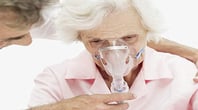For the patient with Chronic Obstructive Pulmonary Disease COPD, in addition to assessing shortness of breath on M1400, also include these Best Practice assessment strategies:
Best Practice Assessment Strategies for Chronic Obstructive Pulmonary Disease COPD
- Determine medication effectiveness and consult with physician as necessary.
- Assess the patient's need for influenza and pneumococcal vaccinations.
- Assess and monitor the patient's respirations and breath sounds, noting rate and sounds (tachypnea, stridor, crackles, wheezes). Note inspiratory and expiratory ratio.
- Observe characteristics of cough (persistent, hacking, moist).

- Monitor and graph serial ABGs, pulse oximetry.
- Monitor the patient's level of consciousness and mental status.
- Evaluate the patient's sleep patterns, note reports of difficulties and whether patient feels well rested.
Best Strategies Answering (M1400) When is the patient dyspneic or noticeably Short of Breath?
Identifies the level of exertion/activity that results in a patient’s dyspnea or shortness of breath.
- 0 - Patient is not short of breath
- 1 - When walking more than 20 feet, climbing stairs
- 2 - With moderate exertion (e.g., while dressing, using commode or bedpan, walking distances less than 20 feet)
- 3 - With minimal exertion (e.g., while eating, talking, or performing other ADLs) or with agitation
- 4 - At rest (during day or night)

Best Practice Assessment Strategies for M1400
- If the patient uses oxygen continuously, select the response based on assessment of the patient’s shortness of breath while using oxygen.
- If the patient uses oxygen intermittently, mark the response based on the patient’s shortness of breath WITHOUT the use of oxygen.
- The response is based on the patient’s actual use of oxygen in the home, not on the physician’s oxygen order.
- The responses represent increasing severity of shortness of breath.
- For a chairfast or bedbound patient, evaluate the level of exertion required to produce shortness of breath.
- The chairfast patient can be assessed for level of dyspnea while performing ADLs or at rest. Response 0 would apply if the patient has not been short of breath during the day of assessment. Response 1 would be appropriate if demanding bed-mobility activities produce dyspnea in the bedbound patient (or physically demanding transfer activities produce dyspnea in the chairfast patient). See Responses 2, 3, and 4 for assessment examples for these patients as well as ambulatory patients
Why are contingency plans good for your home health business?



